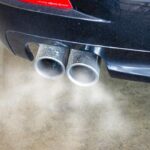If your car is still overheating after replacing the thermostat, you’re not alone. This is a common problem with several potential causes. While a bad thermostat is often the culprit behind overheating, it’s not the only possibility. This article will explore the common reasons why your car might still be overheating even with a new thermostat.
Common Causes of Overheating After Thermostat Replacement
Several issues can cause your car to overheat even after a thermostat replacement. Here are some of the most frequent culprits:
1. Air Pockets in the Cooling System
When you replace the thermostat, air can get trapped in the cooling system. These air pockets prevent coolant from circulating properly, leading to hot spots and overheating. Solution: Properly bleed the cooling system to remove trapped air. Consult your vehicle’s repair manual for the specific bleeding procedure.
2. Faulty Water Pump
The water pump circulates coolant through the engine. If it’s failing or has failed, coolant won’t flow effectively, causing the engine to overheat. Solution: Inspect the water pump for leaks, unusual noises, and wobble. A mechanic can test the water pump’s pressure to ensure it’s functioning correctly. Replace the water pump if necessary.
3. Clogged Radiator
A radiator clogged with debris, rust, or sediment restricts coolant flow and reduces the radiator’s ability to dissipate heat. Solution: Flush the cooling system to remove any blockages. If flushing doesn’t solve the problem, the radiator might need to be replaced. A professional radiator cleaning might be necessary for stubborn clogs.
4. Low Coolant Level
Insufficient coolant in the system won’t effectively cool the engine. Solution: Check the coolant level in the reservoir and radiator when the engine is cold. Add coolant as needed, ensuring you use the correct type specified in your owner’s manual.
5. Radiator Fan Malfunction
The radiator fan helps draw air through the radiator to cool the coolant. If the fan isn’t working correctly, the cooling process is less efficient. Solution: Check the fan’s operation by turning on the air conditioning. The fan should engage. If it doesn’t, check the fan motor, relay, and fuse.
6. Blown Head Gasket
A blown head gasket can allow combustion gases to leak into the cooling system, pressurizing it and causing overheating. It can also lead to coolant leaking into the cylinders or oil. Solution: Perform a head gasket test to confirm a leak. This often involves checking for combustion gases in the coolant or using a leak-down tester. Repairing a blown head gasket is a major repair requiring professional assistance.
Troubleshooting Steps
If your car still overheats after replacing the thermostat, follow these steps:
-
Check for Leaks: Inspect the entire cooling system for leaks. Look for coolant puddles under the car or dripping from hoses and connections.
-
Bleed the System: Properly bleed the cooling system according to your vehicle’s specifications.
-
Inspect the Water Pump: Check the water pump for leaks, noise, and wobble.
-
Verify Radiator Fan Operation: Ensure the radiator fan is functioning correctly.
-
Test the Head Gasket: If other issues are ruled out, perform a head gasket test.
Conclusion
Overheating after a thermostat replacement can be frustrating, but by systematically checking these common causes and following the troubleshooting steps, you can identify the problem and get your car back on the road. If you’re unable to diagnose the issue yourself, consult a qualified mechanic for assistance.

